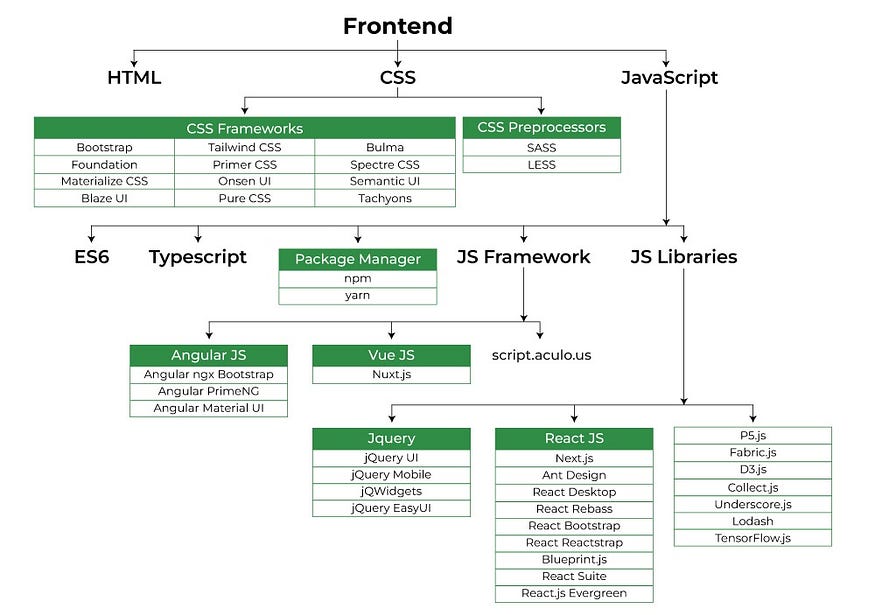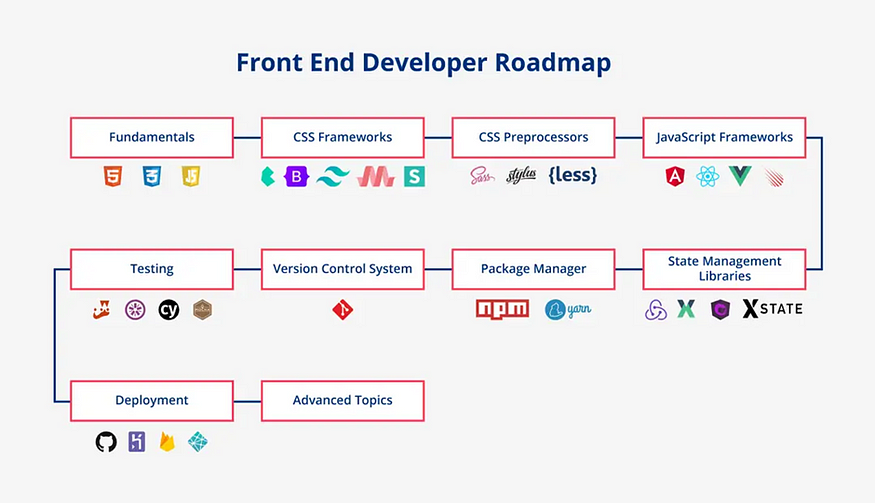What exactly do we mean when we say “Frontend”?
Frontend development, also known as client-side development, is the practice of creating the visual and interactive components of a website or application that users see and interact with.
In the web development process, front-end development comes after the design stage and before the back-end development stage. The frontend developer takes the design files (typically created in tools like Adobe Photoshop or Sketch) into functional, interactive web pages using programming languages such as HTML, CSS, and JavaScript.
Frontend developers also use various tools and frameworks to streamline their workflow and make the development process more efficient. Some popular front-end frameworks include React, Angular, and Vue.js.
Importance of Frontend :
User experience: The frontend is the user’s first point of contact with a website or application, and it determines how the user interacts with the site. A well-designed frontend that is easy to use and aesthetically pleasing can greatly enhance the user experience and keep users engaged.
Responsiveness: With the increasing use of mobile devices, it is essential that websites and applications are designed to be responsive to different screen sizes. Frontend development plays a crucial role in ensuring that websites and applications are optimized for mobile devices and provide a seamless user experience across all devices.
Accessibility: Frontend development can also improve the accessibility of websites and applications for users with disabilities. Using accessible design practices, such as semantic HTML and ARIA (Accessible Rich Internet Applications) attributes, frontend developers can ensure that their websites and applications are usable by a wider audience.
SEO: A well-designed frontend can also improve the search engine optimization (SEO) of a website or application. By using proper HTML tags, structured data, and semantic markup, frontend developers can help search engines better understand the website's content and improve its visibility in search engine results pages.
Performance: The frontend can also affect the performance of a website or application. By optimizing the code, minimizing the number of requests, and using efficient design practices, frontend developers can improve the performance of the website and provide a faster and smoother user experience.
Brand identity: The frontend design is also important for establishing and maintaining a brand’s identity. A consistent design language and visual style across a website or application can help to reinforce a brand’s identity and make it more memorable to users.
Timeline of the evolution

This timeline shows how the initial technologies of HTML, CSS, and the DOM were followed by the addition of JavaScript for interactivity and AJAX for faster loading. Then came the rise of responsive design and CSS frameworks, followed by the shift towards component-based architecture and the emergence of newer CSS technologies like grid/flexbox and CSS variables. More recent additions to the frontend ecosystem include Web Components, PWA, and WebGPU.
Frontend development has come a long way since the early days of the World Wide Web. From basic HTML and CSS to complex component-based frameworks, the evolution of frontend development has been driven by a desire to create more engaging, interactive, and user-friendly web applications. Here’s a closer look at the different stages of frontend development:
A. 1990s: HTML and CSS
In the early days of the web, frontend development consisted primarily of creating simple static pages using HTML and CSS. HTML provided the structure of the page, while CSS was used for styling and layout. These basic tools were sufficient for creating basic websites, but they were limited in terms of interactivity and dynamic content.
B. 2000s: JavaScript
With the advent of JavaScript in the early 2000s, frontend development took a major leap forward. JavaScript made it possible to create more interactive and dynamic web applications, with features like animations, pop-ups, and form validation. JavaScript frameworks like jQuery made it easier to write complex code, and libraries like React and Vue allowed developers to build complex web applications with ease.
C. 2010s: Responsive Design
The rise of mobile devices in the 2010s led to a renewed focus on responsive design. Responsive design is a design approach that ensures that web applications look and function well on any device, regardless of its screen size or orientation. This was accomplished through the use of fluid layouts, flexible images, and CSS media queries.
D. 2020s: Component-based Frameworks
In recent years, frontend development has moved towards component-based frameworks. These frameworks provide a modular approach to building web applications, with reusable components that can be combined to create complex interfaces. Examples of component-based frameworks include Angular, React, and Vue.
The Future of Frontend:
The future of frontend web development is expected to be driven by a combination of emerging technologies, user demands, and developer efficiency. It will continue to evolve rapidly, providing exciting opportunities and challenges for frontend developers to create innovative and user-friendly web applications. Staying updated with the latest trends and technologies and continuously improving skills will be crucial for frontend developers to thrive in the ever-evolving web development landscape.
WebAssembly
WebAssembly (often abbreviated as wasm) is a binary instruction format for a stack-based virtual machine. It is designed as a low-level virtual machine that runs code at near-native speed, making it a powerful technology for frontend web development. Here are some potential future developments for WebAssembly in frontend web development:
1. Increased Adoption: WebAssembly has gained significant momentum since its introduction, and it is expected to continue to grow in adoption.
2. Broader Language Support: Currently, WebAssembly supports several programming languages, including C/C++, Rust, and Go.
AI and ML
The intersection of frontend web development with Artificial Intelligence (AI) and Machine Learning (ML) is an exciting area with significant potential for the future. Here are some key areas where AI and ML may impact frontend web development:
1. Personalized User Experiences: AI and ML technologies can analyze user behavior, preferences, and data to create personalized user experiences on the frontend.
2. Chatbots and Virtual Assistants: AI-powered chatbots and virtual assistants can be integrated into frontend web applications to provide interactive and dynamic interactions with users.
Progressive Web Apps (PWAs):
PWAs are web applications that function like native apps, providing a rich user experience with offline capabilities, push notifications, and seamless updates. PWAs are becoming increasingly popular due to their ability to offer a fast, engaging, and app-like experience on the web, and are likely to play a significant role in the future of frontend web development.
1. Enhanced Offline Capabilities: PWAs are known for their offline capabilities, allowing users to access content and features even without an internet connection.
2. Improved Performance: Performance is a critical factor for web applications, including PWAs.
Challenges and Opportunities
In today’s digital age, front-end development has become an essential component of building any successful web application or website. Frontend development involves designing and developing the visual elements of a web application or website that users interact with. It is the bridge between the user interface and the backend functionality of the application. However, front-end development comes with its own set of challenges and opportunities.
Challenges:
Limited technology: In the early days of frontend development, the technology was limited, which made it difficult to create dynamic and responsive web pages. Developers had to work with basic HTML, CSS, and JavaScript, which made it difficult to create complex layouts and interactions.
Limited tools: There were very few tools available to developers for testing and debugging, which made it difficult to identify and fix errors in code. Developers had to rely on manual testing, which was time-consuming and error-prone.
Browser compatibility: Different browsers had different ways of rendering web pages, which made it challenging to ensure that a website looked and functioned correctly across different browsers. Developers had to create browser-specific hacks and workarounds, which made the codebase more complex.
Lack of standards: In the early days, there were no industry standards for web development, which made it difficult to create consistent and reliable web pages. Developers had to rely on best practices and trial-and-error to figure out what worked and what didn’t.
Performance optimization: Performance optimization is a critical aspect of frontend development. Slow-loading web applications and websites can lead to poor user experience and lost revenue. Ensuring fast load times requires frontend developers to consider various factors such as file size, caching, and rendering time.
Opportunities:
Innovation: Early frontend development was a time of innovation, as developers were experimenting with new ways of creating web pages. This led to the creation of new techniques and tools that are still in use today.
Learning: With limited technology and tools, developers had to be creative and resourceful in solving problems. This led to a deep understanding of the underlying technologies and a strong foundation in the fundamentals of web development.
Flexibility: With no industry standards, developers had the flexibility to create web pages in their own way, which allowed for a lot of creativity and experimentation.
Impact: With the internet still in its early days, early frontend developers had the opportunity to create websites and web applications that had a significant impact on people’s lives. This inspired a generation of developers to continue pushing the boundaries of what was possible with web development.
Overall, early frontend development was a challenging but exciting time for developers. The limitations and challenges of the time pushed developers to be more innovative and creative, which laid the foundation for the modern web development industry.
Conclusion
In conclusion, the evolution of frontend development has been a gradual and continuous process, starting from the foundational technologies of HTML, CSS, and the DOM, and progressing towards more advanced and complex technologies like Web Components, PWA, and WebGPU. As technology has advanced, so has the frontend ecosystem, with each new technology building on the foundations of the previous ones. This evolution has led to the creation of more dynamic, responsive, and interactive web applications, which have become an integral part of our daily lives. The frontend development landscape is constantly evolving, and as new technologies continue to emerge, it will be interesting to see how they shape the future of web development.

